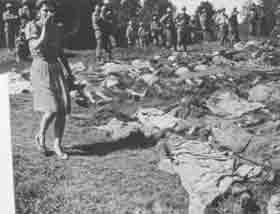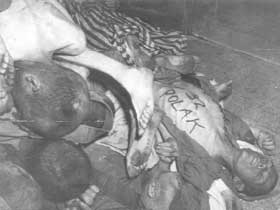The first prisoners arrived in Flossenbürg during Spring 1938. On September 1, 1939, while the German Army was invading Poland, the concentration camp of Dachau was partially evacuated in order to be used as a training center for the future SS extermination squads. 981 prisoners from Dachau were transferred to Flossenbürg. Due to the increasing number of prisoners, the camp was constantly being transformed, and on April 5, 1940, the first convoy of foreign prisoners arrived in Flossenbürg. Living conditions in Flossenbürg were extremely hard. The SS administration itself considered Flossenbürg as a "Hard Regime" concentration camp. Most of the prisoners had to work in the stone quarries. The malnutrition, the total lack of hygiene and medical care, and the brutality of the SS guards were the main causes of the death of thousands of prisoners in Flossenbürg as well as in its sub-camps.
"polak" (insult used by the SS for the Polish prisoners)
The prisoners in Flossenbürg were housed in 16 huge wooden barracks. The camp also had a kitchen, an infirmary ("Revier"), a laundry, and a disinfecting house. There were crematories and an execution place located just beside the crematories for "practical reasons" – (dixit) according to the SS. The whole camp was surrounded by an electrified barbed wire fence and watch towers. Two of those watch towers still remain today. The original camp was established in 1938 for 1,600 prisoners. Some months later, the camp was transformed in order to house 3,000 prisoners. Eventually, more than 111,000 prisoners were incarcerated in Flossenbürg and its sub-camps - 95,400 men and 16,000 women. It is estimated that 73,000 prisoners died. The camp was liberated on April 23, 1945, by the 2nd U.S. Calvary. There were only some hundreds of ill and weak prisoners left. The other prisoners — more than 14,000 men and women — were forced by the SS to leave the camp in a Death March some days before the Allied troops arrived. Three days after the liberation of the main camp, a U.S. unit retrieved the survivors of this Death March. All of them were in pitiful condition, and in only three days, more than 4,000 prisoners died of weakness or starvation, or killed by the SS. Sources: The Forgotten Camps |

